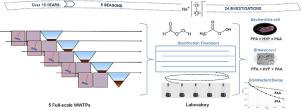Water Research ( IF 11.4 ) Pub Date : 2020-07-11 , DOI: 10.1016/j.watres.2020.116169 Patrizia Ragazzo 1 , Nicoletta Chiucchini 1 , Valentina Piccolo 1 , Monica Spadolini 1 , Stefano Carrer 1 , Francesca Zanon 2 , Ronald Gehr 3

|
Chemical disinfection of municipal wastewater to preserve the microbiological quality of discharges has traditionally relied on chlorine, and more recently on peracetic acid (PAA). A more recent option is performic acid (PFA). This work uses laboratory and full-scale studies over a span of 15 years and five wastewater treatment plants (WWTPs) in Italy, to compare the efficacy of these three disinfectants and identify the differences among peracids in a context where both can be an alternative to chlorine. The investigations focused on treatment effectiveness and bacterial inactivation kinetics using E. coli and the more resistant enterococci, as well as on PFA and PAA decomposition as the residuals may affect the downstream microenvironment. Furthermore, the potential for the two peracids to oxidize organic substances and create troublesome byproducts was also studied. Chlorine, applied as hypochlorite (“HYP”) and here essentially functioning as chloramines, was used as a baseline comparison for the two peracids. Appropriate statistical tests were applied to the data from different WWTPs to account for potential interferences and compounding effects of the different matrices. Average doses of 0.8, 2.9 and 1.4 mg/L and contact times of 18, 21 and 31 min, respectively for PFA, chlorine and PAA guaranteed with a high level of assurance the 5000 CFU/100 mL E. coli limit; the order of effectiveness was PFA > HYP > PAA, refined as PFA > HYP ≈ PAA against E. coli and PFA ≈ HYP > PAA with enterococci. Similar bacterial reductions for the peracids were found at higher disinfectant doses used for the kinetic tests. PFA decayed more quickly than PAA. The first-order decay constants were 0.031 and 0.007 min−1, respectively, suggesting that disinfection residuals when PFA is used may be less of a concern than with PAA. This faster decomposition did not affect the PFA oxidation power on estrone, which was as weak as that of PAA.
中文翻译:

废水消毒:与过氧乙酸和氯相比,对过甲酸进行长期的实验室和全面研究。
传统上,对市政废水进行化学消毒以保持排放物的微生物质量一直依靠氯,最近依靠过氧乙酸(PAA)。最近的选择是过甲酸(PFA)。这项工作使用了长达15年的实验室和全面研究以及意大利的五个废水处理厂(WWTP),以比较这三种消毒剂的功效,并在两种酸都可以替代的情况下确定过酸之间的差异。氯。研究集中于使用大肠杆菌的治疗效果和细菌灭活动力学肠球菌以及PFA和PAA分解更具抵抗力,因为残留物可能影响下游的微环境。此外,还研究了两种过酸氧化有机物质并产生麻烦的副产物的可能性。用作次氯酸盐(“ HYP”)的氯在这里基本起氯胺的作用,被用作两种过酸的基线比较。对来自不同污水处理厂的数据进行了适当的统计检验,以说明不同矩阵的潜在干扰和复合影响。PFA,氯和PAA的平均剂量分别为0.8、2.9和1.4 mg / L,接触时间分别为18、21和31分钟,并以高度保证的水平保证了5000 CFU / 100 mL大肠杆菌限制; 有效性的顺序为:PFA> HYP> PAA,对大肠杆菌进行细化为PFA> HYP≈PAA,对肠球菌则为PFA≈HYP> PAA。在用于动力学测试的较高消毒剂量下,发现过酸的细菌减少量相似。PFA比PAA衰减更快。一阶衰减常数分别为0.031和0.007 min -1,这表明与使用PAA相比,使用PFA时的消毒残留可能更少。这种更快的分解不会影响雌酮上的PFA氧化能力,后者与PAA一样弱。











































 京公网安备 11010802027423号
京公网安备 11010802027423号